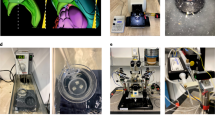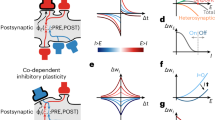Abstract
LONG-TERM potentiation1,2 of chemical synapses is closely related to memory and learning3,4. Studies of this process have concentrated on chemically mediated excitatory synapses. By contrast, activity-dependent modification of gap junctions, which also widely exist in higher structures such as hippocampus and neocortex5, has not been described. Here we report that at mixed synapses between sensory afferents and an identified reticulospinal neuron, the electrotonic coupling potential can be potentiated, as well as the chemically mediated excitatory postsynaptic potential, for a prolonged time period using a stimulation paradigm like that which produces long-term potentiation in hippocampus. The effect on coupling is due to an increase in gap-junctional conductance. Our data indicate that the potentiation of both synaptic components requires an increase in intracellular calcium, involves activation of NMDA (N-methyl-D-aspartate) receptors, and is specific to the tetanized pathway.
This is a preview of subscription content, access via your institution
Access options
Subscribe to this journal
Receive 51 print issues and online access
$199.00 per year
only $3.90 per issue
Buy this article
- Purchase on Springer Link
- Instant access to full article PDF
Prices may be subject to local taxes which are calculated during checkout
Similar content being viewed by others
References
Bliss, T. V. P. & Lomo, T. J. Physiol., Lond. 232, 311–356 (1973).
Lomo T. Acta Physiol. Scand. 68, (suppl. 277) 128 (1966).
Brown, T. H., Chapman, P. F., Kairiss, E. W. & Keenan, C. L. Science 242, 724–728 (1988).
Gustafsson, B. & Wigstrom, H. Trends Neurosci. 11, 156–162 (1988).
Dudek, F. E., Andrew, R. D., MacVicar, B. A., Snow, R. W. & Taylor, C. P. in Basic Mechanisms of Neuronal Hyperexcitability (eds Jasper, H. H. & Van Gelder, N. M.) 31–73 (Liss, New York, 1983).
Lin, J. W. & Faber, D. S. J. Neurosci. 8, 1302–1325 (1988).
Wolszon, L. R. & Faber, D. S. Soc. Neurosci. Abst. 14, 939 (1988).
Fay, R. R. & Olsho, L. W. Comp. Biochem. Physiol. 62A, 377–386 (1979).
Faber, D. S. & Korn, H. Neurobiology of the Mauthner Cell (eds Faber, D. S. & Korn, H.) 47–132 (Raven, New York, 1978).
Zottoli, S. J., Hordes, A. R. & Faber, D. S. Brain Res. 401, 113–121 (1987).
Lynch, G., Larson, J., Kelso, S., Barrionuevo, G. & F. Schottler, Nature 305, 719–721 (1983).
Malenka, R. C., Kauer, J. A., Perkel, D. J. & Nicoll, R. A. Trends Neurosci. 12, 444–450 (1989).
Tsien, R. Y. Biochemistry 19, 2396–2404 (1980).
Williams, S. & Johnson, D. Neuron 3, 583–588 (1989).
Collingridge, G. L., Kehl, S. J. & McLennan, H. J. Physiol., Lond. 334, 33–46 (1983).
Collingridge, G. L. & Bliss, T. V. B. Trends Neurosci. 10, 288–293 (1987).
Zalutsky, R. A. & Nicoll, R. A. Science 248, 1619–1624 (1990).
Ascher, P. & Nowak, L. J. Physiol., Lond. 399, 207–266 (1988).
Mayer, M. L. & Westbrook, G. L. J. Physiol., Lond. 394, 501–528 (1987).
Davies, J. et al. Brain Res. 382, 169–173 (1986).
Harris, E. W., Ganong, A. H., Monaghan, D. T., Watkins, J. C. & Cotman, C. W. Brain Res. 382, 174–177 (1986).
Anis, N. A., Berry, S. C., Burton, N. R. & Lodge, D. Br. J. Pharmac. 79, 565–575 (1983).
Honey, C. R., Miljkovic, Z. & MacDonald, J. F. Neurosci. Lett. 61, 135–139 (1985).
MacDonald, J. F., Miljkovic, Z. M. & Pennefather, P. J. Neurophysiol. 58, 251–266 (1987).
Benoit, E., Carrutu, M. R., Dubois, J. M. & Mitolo-Chieppa, D. M. Br. J. Pharmac. 87, 281–297 (1986).
D'Angelo, E., Rossi, P. & Garthwaite, J. Nature 346, 467–470 (1990).
Loewenstein, W. R. Physiol. Rev. 61, 829–913 (1981).
Zottoli, S. J. J. exp. Biol. 66, 243–254 (1979).
Author information
Authors and Affiliations
Rights and permissions
About this article
Cite this article
Yang, XD., Korn, H. & Faber, D. Long-term potentiation of electrotonic coupling at mixed synapses. Nature 348, 542–545 (1990). https://doi.org/10.1038/348542a0
Received:
Accepted:
Issue Date:
DOI: https://doi.org/10.1038/348542a0
This article is cited by
-
Convergent NMDA receptor—Pannexin1 signaling pathways regulate the interaction of CaMKII with Connexin-36
Communications Biology (2021)
-
NMDAR-mediated modulation of gap junction circuit regulates olfactory learning in C. elegans
Nature Communications (2020)
-
Long-term potentiation in an innexin-based electrical synapse
Scientific Reports (2018)
-
Immediate early gene expression related to learning and retention of a visual discrimination task in bamboo sharks (Chiloscyllium griseum)
Brain Structure and Function (2018)
-
Activity-dependent plasticity of electrical synapses: increasing evidence for its presence and functional roles in the mammalian brain
BMC Cell Biology (2016)
Comments
By submitting a comment you agree to abide by our Terms and Community Guidelines. If you find something abusive or that does not comply with our terms or guidelines please flag it as inappropriate.



